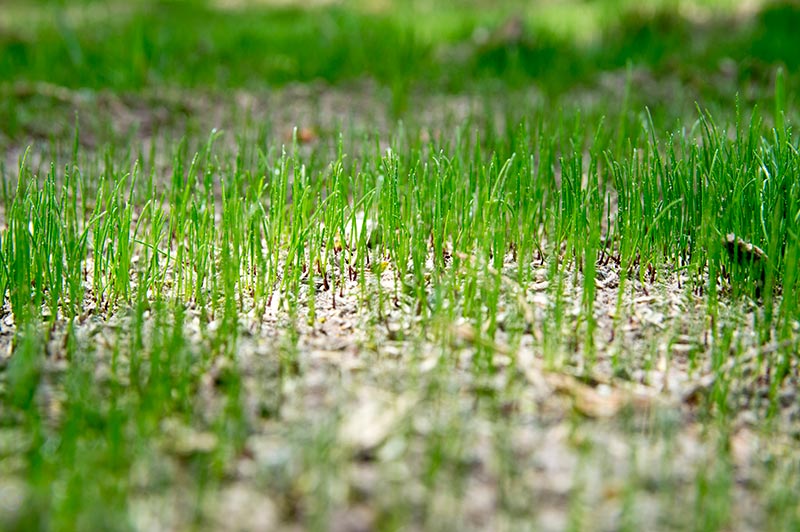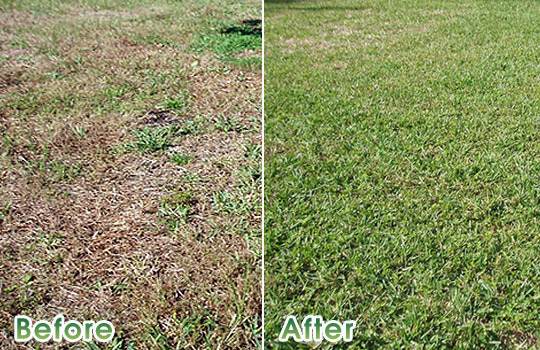Lawn fertilizer works by providing essential nutrients to the grass, promoting healthy growth and development. Lawns require nutrients such as nitrogen, phosphorus, and potassium, which are typically included in fertilizers.
These nutrients are absorbed by the grass and utilized for important functions like photosynthesis, root development, and overall plant health. By supplying these nutrients, lawn fertilizer helps maintain a lush, green lawn and prevents nutrient deficiencies that can lead to weak and sparse grass.
Applying fertilizer at the appropriate times and in the correct amounts ensures optimal effectiveness and encourages a thriving lawn.

Credit: www.pennington.com
How Does Lawn Fertilizer Work: Step by Step Guide
The Basics Of Lawn Fertilizer
Lawn fertilizer works by providing essential nutrients to promote healthy lawn growth. Understanding the components of fertilizer is crucial for effective lawn care. Macronutrients play a vital role in supporting overall lawn health. They include nitrogen, phosphorus, and potassium, which are necessary for proper plant development.
These nutrients help with leaf growth, root establishment, and overall strength. Micronutrients, on the other hand, are required in smaller quantities but are equally important. These include iron, zinc, and manganese, among others, and help plants function optimally, aiding in photosynthesis and enzyme activation.
By understanding the composition of fertilizer, you can provide your lawn with the nutrients it needs to thrive, ensuring a lush and vibrant outdoor space. So, ensure you choose a well-balanced fertilizer that contains both macronutrients and micronutrients for optimal lawn health.
The Science Behind Lawn Fertilizer
Lawn fertilizer works by providing essential nutrients to the soil, which are then absorbed by plants. Various factors, such as soil ph, nutrient concentration, and organic matter content, affect the availability of nutrients in the soil. The process of nutrient absorption by plants involves the plants’ roots absorbing the dissolved nutrients in water.
Fertilizers play a crucial role in promoting photosynthesis, the process by which plants convert sunlight into energy. They provide the necessary elements, like nitrogen, phosphorus, and potassium, which are essential for chlorophyll production, enabling plants to efficiently use light energy.
As a result, fertilized lawns often exhibit greener, healthier grass, as they receive an extra boost of nutrients that may be lacking naturally. By understanding the science behind lawn fertilizer and the process of nutrient absorption, gardeners can effectively maintain and enhance the health and vibrancy of their lawns.
Different Types Of Lawn Fertilizers
Lawn fertilizers work by supplying essential nutrients to promote healthy grass growth and overall lawn health. When it comes to different types of fertilizers, granular fertilizers are a popular option. They have pros and cons worth considering. Granular fertilizers are easy to apply and have a slow-release formula, ensuring a steady nutrient supply.
However, they require water to activate and may take longer to see results. Another type of fertilizer is liquid fertilizers. These work by directly feeding the grass through the roots and leaves. They are fast-acting and quickly absorbed by the plant, resulting in rapid growth.
Lastly, organic fertilizers offer an eco-friendly alternative. They are made from natural materials and provide long-lasting benefits. Organic fertilizers improve soil structure, promote microbial activity, and enhance overall soil health.
Decoding Fertilizer Labels
Lawn fertilizer works by providing essential nutrients to the grass, promoting healthy growth and development. Decoding fertilizer labels is key to understanding how to effectively use these products. N-p-k ratios, which represent the proportion of nitrogen, phosphorus, and potassium in the fertilizer, play a crucial role in determining the fertilizer’s effectiveness.

Additionally, secondary nutrients and trace elements, such as calcium, magnesium, and iron, are also important for maintaining a vibrant lawn. These components support various metabolic processes and help plants withstand stress and disease. When reading fertilizer labels, it is important to interpret other information provided, such as application rates, frequency, and special instructions.
By understanding these details, homeowners can choose the right fertilizer and use it appropriately for optimal lawn health and appearance. So, let’s delve into the fascinating world of lawn fertilizers and unlock the secrets behind lush, green lawns.
Applying Lawn Fertilizers
Lawn fertilizer works by supplying essential nutrients to the soil, promoting healthy grass growth. When applying lawn fertilizers, it is crucial to follow best practices to maximize effectiveness. Calculating the correct amount of fertilizer to use is important to avoid under or over-fertilization.
Over-fertilization can lead to nutrient burn, causing damage to the grass. To prevent this, it is recommended to carefully measure and evenly distribute the fertilizer across the lawn. It is also beneficial to water the lawn after application to facilitate nutrient absorption.
By adhering to these practices, you can ensure that your lawn receives the right amount of nutrients without the risk of damage. Maintain a lush and green lawn by employing proper fertilizer application techniques.
The Impact Of Lawn Fertilizer On The Environment
Lawn fertilizer plays a crucial role in promoting healthy grass growth and vibrant landscapes. However, it’s important to understand the impact of these fertilizers on the environment. Nutrient runoff, which occurs when excess fertilizer washes away, can contribute to water pollution.
This runoff carries nitrogen and phosphorous into nearby water bodies, causing algal blooms and disrupting aquatic ecosystems. To reduce this environmental impact, eco-friendly alternatives to traditional fertilizers have emerged, such as organic or slow-release options. These alternatives release nutrients gradually, minimizing the risk of runoff.
Additionally, responsible fertilizer use in landscaping can help mitigate environmental harm. This includes following manufacturer guidelines, properly timing fertilizer application, and avoiding over-application. By adopting these practices, we can ensure that our lawns remain healthy, while also preserving the integrity of our ecosystems.
Troubleshooting Common Lawn Fertilizer Issues
Lawn fertilizer works by providing essential nutrients that promote healthy growth and development. Signs of nutrient deficiencies in lawns include yellowing grass, stunted growth, and thinning patches. Dealing with excessive weed growth after fertilizing can be frustrating, but it’s important to address it promptly.
One way to tackle this issue is by using a selective herbicide specifically designed to target weeds without harming the grass. Another common problem is lawn burn and yellowing, which can occur if fertilizer is applied incorrectly or in excessive amounts.
To avoid this, always follow the instructions on the fertilizer packaging and water the lawn after applying the fertilizer. Maintaining a proper fertilization schedule and addressing any issues promptly can help keep your lawn lush and healthy. So, keep an eye out for nutrient deficiencies, deal with weed growth, and prevent lawn burn to ensure a beautiful green lawn.
Frequently Asked Questions About Lawn Fertilizer
Lawn fertilizer works by providing essential nutrients to promote healthy grass growth. It is commonly used to improve soil quality, increase root development, and enhance the overall appearance of lawns. For frequently asked questions about lawn fertilizer, one common query is how often to fertilize the lawn.
Timing will depend on factors such as grass type and climate, but typically, fertilizing every 6-8 weeks during the growing season is recommended. Another question often asked is whether lawn fertilizer can be used on other plants. While some fertilizers may be suitable for multiple plant types, it is best to use products specifically designed for the needs of each plant.
Lastly, there is a growing interest in organic fertilizer due to environmental concerns. Organic options are considered better for the environment as they are derived from natural sources and have minimal impact on soil and water quality.
Frequently Asked Questions Of How Does Lawn Fertilizer Work
How Does Lawn Fertilizer Work?
Lawn fertilizer works by providing essential nutrients to the grass, such as nitrogen, phosphorus, and potassium. These nutrients help promote healthy growth, strengthen roots, and enhance color. When applied correctly, the fertilizer is absorbed by the grass roots and used to support overall lawn health.
What Are The Benefits Of Using Lawn Fertilizer?
Using lawn fertilizer offers a range of benefits, including promoting healthy and vigorous growth, preventing weed development, improving drought resistance, and enhancing the overall appearance of your lawn. The nutrients in the fertilizer provide essential elements that help nourish the grass and keep it strong and vibrant.
When Should I Apply Lawn Fertilizer?
The timing of applying lawn fertilizer depends on various factors, such as the type of grass, soil conditions, and climate. Generally, it is recommended to apply fertilizer in early spring and fall, when the grass is actively growing. It is essential to follow the manufacturer’s instructions and local recommendations for best results.
How Much Lawn Fertilizer Should I Use?
The amount of lawn fertilizer to use depends on factors such as the size of your lawn, type of grass, and the specific product you are using. It is crucial to follow the product instructions and guidelines on the label.

Over-fertilization can harm your lawn, so it’s important to apply the correct amount according to the recommended dosage.
Can Lawn Fertilizer Harm The Environment?
When used correctly, lawn fertilizer should not harm the environment. However, if applied excessively or improperly, fertilizer runoff can contribute to water pollution. To minimize the risk, avoid fertilizing before heavy rain, follow application instructions, and consider using slow-release or organic fertilizers that release nutrients more slowly and reduce runoff.
Conclusion
To sum it up, lawn fertilizer is a crucial tool for maintaining a healthy and vibrant lawn. It works by providing essential nutrients to the soil, which in turn promotes optimal plant growth. The key ingredients in lawn fertilizers, such as nitrogen, phosphorus, and potassium, play a vital role in nourishing the grass and helping it withstand various environmental stresses.
By understanding the specific needs of your lawn and choosing the right type of fertilizer, you can effectively enhance its overall health and appearance. It’s important to remember that proper application and timing are essential for achieving the best results.
Regularly fertilizing your lawn, along with good watering and mowing practices, will help ensure a lush and beautiful landscape for years to come. So, give your lawn the nourishment it deserves and enjoy the benefits of a healthy and vibrant outdoor space.

